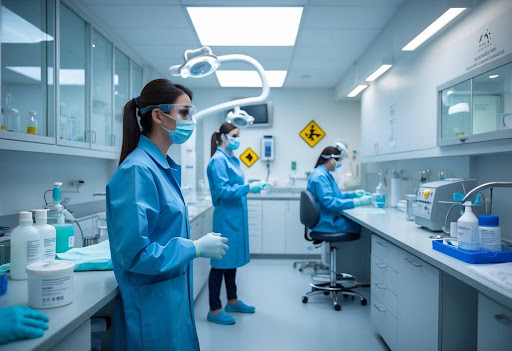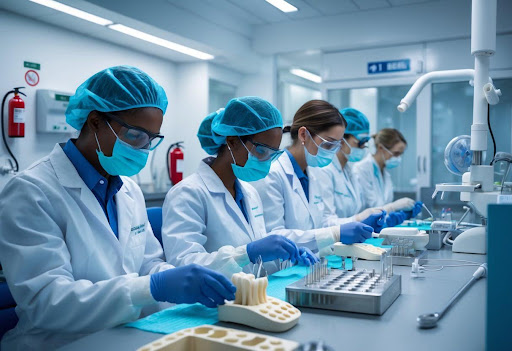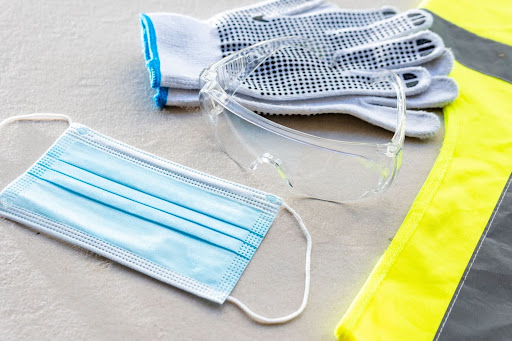A Guide to Dental Lab Safety Standards: Essential Protocols for Compliance and Best Practice
Posted on: 08/07/2025
Maintaining high safety standards in your dental laboratory not only protects staff from daily risks but also ensures the quality and integrity of every dental product created. In a bustling environment filled with sharp tools, chemicals, and intricate equipment, strict health and safety protocols are essential to prevent accidents and safeguard everyone involved.

You’ll find that the Health and Safety at Work Act 1974 plays a key role in defining your legal responsibilities, requiring you to keep both your team and visitors safe. For instance, regularly inspecting equipment, offering ongoing safety training, and encouraging open communication about hazards can make a big difference. Fun fact: well-organised safety procedures have been shown to reduce workplace injuries in dental labs across the UK.
To help you meet and exceed these requirements, this guide offers practical tips, suggestions for regular safety audits, and advice on building a culture of awareness. Whether you’re setting up a new laboratory or refining your existing safety protocols, you’ll discover straightforward ways to keep your workplace both compliant and efficient.
Dental laboratories work with sharp tools, hazardous chemicals, and intricate equipment. Understanding and following safety standards helps prevent injuries, ensures product quality, and protects everyone in the lab.
Complying with dental lab safety regulations protects you, your colleagues, and patients. It’s not just about ticking boxes; non-compliance can result in serious injuries, fines, or loss of licence.
The Health and Safety at Work Act 1974, for instance, legally requires employers to create a safe working environment. This covers staff, visitors, and even people who may be indirectly affected by your work, such as delivery drivers or patients. Regular safety training sessions and audits help you recognise risks and improve your workplace safety culture.
Tip: Display key safety rules in visible locations, and review them during team meetings.
Multiple agencies oversee dental lab safety in the UK. The main ones include the Health and Safety Executive (HSE) and the General Dental Council (GDC). The DLA (Dental Laboratories Association) also helps interpret and promote new standards.
Key regulations you should know:
Each rule addresses specific risks, such as chemical spills or equipment operations. For instance, COSHH requires you to store and label all chemicals correctly, minimising accidental contact or inhalation.
Fun fact: Lab safety audits are usually conducted yearly, but surprise checks can happen at any time.
Core safety standards focus on risk prevention, equipment safety, and personal protection. Ventilation systems control dust and fumes, while high-quality lighting reduces the risk of mistakes.
You must use protective equipment like gloves, masks, and safety glasses when working with resins or polishing tools. Designated working areas, regular equipment inspections, and proper waste disposal are central to daily lab routines.
Consider making a weekly checklist for cleaning and maintenance tasks. This ensures nothing slips through the net and creates a safer, more efficient work environment.

Effective risk assessment and control in the dental lab hinges on recognising potential hazards, applying robust safety protocols, and maintaining accurate records. Protecting staff health, ensuring legal compliance, and reducing incidents all depend on careful management in these key areas.
Begin by walking through your lab and listing all obvious and hidden risks. Common hazards include sharp instruments, chemical exposure, noise, and biological materials such as saliva or blood. Look beyond immediate risks—electrical equipment, heat sources, and even poor lighting can also contribute to workplace injuries.
Check all areas: workbenches, storage rooms, and maintenance zones. Use a checklist to help, noting hazards you might miss in routine tasks. Pay attention to processes like mixing dental materials or cleaning equipment, as these can introduce additional risks.
Gather input from your team. Ask what tasks they find hazardous or challenging. Encourage a culture where everyone is alert to new dangers, as workplace hazards can change with new technology or procedures.
Once you've identified hazards, set clear safety protocols for each one. Use a combination of personal protective equipment (PPE), safe work practices, and engineering controls. For example, provide nitrile gloves, safety glasses, and masks when handling chemicals or working near aerosols.
Clearly display step-by-step procedures for handling sharps, disinfecting equipment, and disposing of waste. Conduct regular safety briefings, and make sure everyone knows how to report incidents. Use colour-coded bins for materials disposal and post signs to highlight no-go areas.
Leadership should demonstrate a visible commitment to safety. Appoint a safety officer, schedule frequent training sessions, and follow up on incident reports. Review protocols annually, or after any significant incident, to ensure they remain effective.
Keep thorough records of risk assessments, adopted protocols, staff training, and incident reports. Use printed forms or digital logs to ensure nothing gets overlooked. Store records securely but make them accessible for inspections or audits.
Update documentation after all safety reviews or when you change work processes. Keep a file of safety data sheets (SDS) for chemicals in use. Tip: Label shelves and containers with date-received stickers to track expiry and disposal dates easily.
Accurate record-keeping not only meets legal requirements but also supports a safer, more efficient lab. Regular audits help you spot recurring problems and prove due diligence if any incident occurs.
Using the right personal protective equipment (PPE) and following strict hygiene procedures greatly reduces the risk of injury or infection in a dental laboratory. Selecting and caring for PPE, along with maintaining hand hygiene, is crucial to your daily workflow and safety.
Dental labs require several specific types of PPE. Gloves, masks, protective eyewear, and lab coats are standard. Use gloves when handling chemicals or contaminated items, and remember to choose nitrile or latex for better protection.
Face masks filter airborne particles produced during grinding or polishing dental materials. Protective eyewear shields your eyes from splashes and flying debris. Lab coats or gowns protect your clothing and skin from chemicals and biological material.
Choose equipment that fits comfortably without restricting movement. Respirators may be necessary when working with certain fine particulates or large volumes of chemical vapour. Always check that your PPE meets UK standards for dental laboratory environments.
Wearing PPE correctly is as important as having the right equipment. Make sure masks cover both nose and mouth, and always tuck loose hair into caps or hairnets. Remove gloves carefully to prevent contact with contaminants.
Change disposable items such as gloves and masks between each case or when visibly soiled. Clean and disinfect eyewear and reusable gowns after use. Store PPE in a clean area away from contamination sources; never reuse single-use items.
Inspect equipment regularly for damage. Replace anything with holes, tears, or wear that could compromise safety. Train staff to understand both why and how to use PPE properly—consistent use saves time and prevents accidents.
Effective hand hygiene prevents cross-contamination in the lab. Wash your hands with soap and water for at least 20 seconds before putting on gloves and after removing them. Use alcohol-based hand rubs if hands are not visibly dirty, ideally with at least 60% alcohol.
Moisturise hands regularly to avoid dry, cracked skin which can harbour microbes. Keep fingernails short and avoid wearing rings or bracelets that can trap debris. If you develop dermatitis or skin irritation, seek medical advice to prevent infection risks.
Create visual reminders within the laboratory to prompt proper hand washing. Make sure sinks have easy access to soap, paper towels, and hand sanitiser. Infection control isn’t just about following rules; it’s about protecting everyone working in the lab.

Dental labs face exposure to chemicals and biological agents that can harm staff and disrupt operations. Understanding precise handling, containment, and disposal steps keeps everyone protected and upholds compliance requirements.
You must identify all chemicals used in the dental lab, including acids, solvents, and alloys. Always label every container clearly with its name and hazard symbols. Store chemicals in designated cabinets away from heat sources and direct sunlight.
Each chemical should have a corresponding safety data sheet (SDS) accessible for quick reference. Wear suitable personal protective equipment (PPE), such as nitrile gloves and safety goggles, when handling or decanting chemicals.
Make sure incompatible substances, such as oxidisers and flammable liquids, are kept apart. Consider creating a colour-coded chart for storage areas. Ventilation is crucial, so use local exhaust systems or fume cupboards for processes producing fumes or vapours.
Never pour chemicals back into their original container after use. Regularly inspect storage areas for signs of leaks or spills, and keep a spill kit on hand within 25 feet (8 metres) of chemical storerooms.
You risk coming into contact with blood, saliva, and other infectious materials while handling dental impressions and prosthetics. It’s important to treat all materials from patients as potentially infectious, regardless of origin.
Wear disposable gloves, masks, and eye protection when processing incoming work. Disinfect all items before handling them with a suitable biocidal agent, following the contact time recommended by manufacturers.
Surfaces and tools should be cleaned with disinfectant between each job. Wash your hands thoroughly with soap and warm water after removing gloves. Immunisations against hepatitis B are recommended for lab workers.
If an accidental exposure occurs, such as a needle prick or mucous membrane contact, report it immediately and seek medical advice.
Quick response to chemical and biological spills reduces risks. First, alert nearby staff and isolate the area to prevent spread or accidental exposure.
Use a spill kit designed for dental lab hazards, which usually contains absorbent materials, neutralisers, gloves, and goggles. For small chemical spills, cover the spill with absorbent, then dispose of it in a chemical waste container.
In the case of biological spills, apply a disinfectant with proven efficacy against bloodborne pathogens, allow the required dwell time, and then mop up. Clearly display an emergency contact number near workstations.
Document any spill incidents, no matter how minor, in the lab’s safety log. This helps refine future training and ensures regulatory compliance.
Lab waste falls into several types: chemical, biological, sharps, and general. Sort all waste at the point of generation—don’t mix categories. Use sturdy, puncture-proof containers for sharps like needles and blades.
Chemical waste, such as used acids or amalgam, requires special containers labelled with contents and hazards. Arrange for collection by a licensed waste contractor.
Dispose of biological waste, including contaminated gauze and impressions, in marked, leak-proof bags. Store filled bags in a secure area awaiting collection.
Always verify your waste contractor’s credentials, and review disposal procedures annually to keep up-to-date with regulations.
Ensuring dental equipment is properly maintained and used reduces the risk of malfunctions, injuries, and costly repairs. Following organised protocols also keeps you compliant with legal and professional standards.
You should carry out scheduled inspections for all dental laboratory equipment, including autoclaves, mixers, handpieces, and casting machines. Create a daily, weekly, and monthly checklist to monitor operational safety and identify potential hazards.
Make sure to record each inspection in a logbook. Note any issues you spot and resolve them promptly, rather than postponing maintenance.
Store equipment manuals in an accessible place for quick reference. If feint readings or odd noises arise, address them early to prevent breakdowns. Remember, even a small calibration error in a steriliser can compromise infection control.
Only trained staff should operate complex machines such as casting units or furnaces. Always review the manufacturer’s instructions and safety features before use. For example, ensure shielded guards are in place before running high-speed polishers.
Use PPE such as safety glasses, gloves, and, for certain equipment, dust masks or respirators. Switch off and unplug machinery before cleaning, fixing, or changing accessories.
Maintain clear signage for potentially hazardous areas. If your autoclave must reach 250°F (121°C) during cycles, never open the chamber while pressured.
Report any malfunction immediately and tag faulty items with a “Do Not Use” label to alert colleagues. Your attention to detail in daily routines builds a safer working environment for everyone.

Proper dental lab safety involves compliance with legal standards, thorough infection control, and environmental safeguards. Staying updated on regulations protects both dental workers and patients from preventable risks.
You should always use personal protective equipment (PPE), such as gloves, masks, and goggles, during all dental procedures and laboratory work. Disinfect all surfaces and equipment between patients, and dispose of single-use items after each use.
Hand hygiene is critical; wash hands before and after glove use and after patient contact. Instruments must be sterilised using an autoclave, and reusable items require meticulous cleaning.
You must train all staff on hazard communication and proper handling of chemicals. Chemicals in the lab must be labelled and stored safely, and records kept safe for inspections.
Ventilation systems should be sufficient to minimise exposure to toxic fumes. Sharp instruments and contaminated materials should be disposed of in puncture-resistant, labelled containers to reduce injury risks.
Lead aprons and thyroid collars must be provided to patients during X‐ray procedures. Operators should stand behind a protective barrier or maintain at least six feet (around 1.8 metres) away from the X-ray source.
Only trained personnel should operate radiographic equipment. Regularly inspect machines for faults and keep exposure times as short as possible.
Start each day by checking the functionality and cleanliness of sterilisation equipment. Use colour‐coded cleaning materials to prevent cross‐contamination.
Limit accessory items in treatment areas to simplify cleaning and disinfection. Always keep detailed logs of sterilisation cycles, maintenance, and any incidents of exposure.
Install flooring that is non‐porous, smooth, and able to withstand frequent cleaning with disinfectants. Materials like vinyl and smooth tile are popular because they prevent fluid absorption.
Floors should be slip-resistant to protect staff and patients from falls. Avoid carpeting in clinical areas, as it can harbour pathogens and is challenging to clean properly.
Review your protocols at least annually or whenever guidelines from authorities like the CDC or local health departments change. Promptly update procedures following new research, outbreaks, or on-site incidents.
Regular staff training sessions ensure everyone understands the latest practices. A quick tip: set calendar reminders for regular policy reviews and assign a safety lead to track compliance.

You’ll find that the Health and Safety at Work Act 1974 plays a key role in defining your legal responsibilities, requiring you to keep both your team and visitors safe. For instance, regularly inspecting equipment, offering ongoing safety training, and encouraging open communication about hazards can make a big difference. Fun fact: well-organised safety procedures have been shown to reduce workplace injuries in dental labs across the UK.
To help you meet and exceed these requirements, this guide offers practical tips, suggestions for regular safety audits, and advice on building a culture of awareness. Whether you’re setting up a new laboratory or refining your existing safety protocols, you’ll discover straightforward ways to keep your workplace both compliant and efficient.
Overview of Dental Lab Safety Standards
Dental laboratories work with sharp tools, hazardous chemicals, and intricate equipment. Understanding and following safety standards helps prevent injuries, ensures product quality, and protects everyone in the lab.
Importance of Regulatory Compliance
Complying with dental lab safety regulations protects you, your colleagues, and patients. It’s not just about ticking boxes; non-compliance can result in serious injuries, fines, or loss of licence.
The Health and Safety at Work Act 1974, for instance, legally requires employers to create a safe working environment. This covers staff, visitors, and even people who may be indirectly affected by your work, such as delivery drivers or patients. Regular safety training sessions and audits help you recognise risks and improve your workplace safety culture.
Tip: Display key safety rules in visible locations, and review them during team meetings.
Key Agencies and Regulations
Multiple agencies oversee dental lab safety in the UK. The main ones include the Health and Safety Executive (HSE) and the General Dental Council (GDC). The DLA (Dental Laboratories Association) also helps interpret and promote new standards.
Key regulations you should know:
- Health and Safety at Work Act 1974
- Control of Substances Hazardous to Health (COSHH)
- Personal Protective Equipment at Work Regulations
Each rule addresses specific risks, such as chemical spills or equipment operations. For instance, COSHH requires you to store and label all chemicals correctly, minimising accidental contact or inhalation.
Fun fact: Lab safety audits are usually conducted yearly, but surprise checks can happen at any time.
Core Principles of Safety Standards
Core safety standards focus on risk prevention, equipment safety, and personal protection. Ventilation systems control dust and fumes, while high-quality lighting reduces the risk of mistakes.
You must use protective equipment like gloves, masks, and safety glasses when working with resins or polishing tools. Designated working areas, regular equipment inspections, and proper waste disposal are central to daily lab routines.
Consider making a weekly checklist for cleaning and maintenance tasks. This ensures nothing slips through the net and creates a safer, more efficient work environment.
Workplace Risk Assessment and Management

Effective risk assessment and control in the dental lab hinges on recognising potential hazards, applying robust safety protocols, and maintaining accurate records. Protecting staff health, ensuring legal compliance, and reducing incidents all depend on careful management in these key areas.
Identifying Hazards in Dental Laboratories
Begin by walking through your lab and listing all obvious and hidden risks. Common hazards include sharp instruments, chemical exposure, noise, and biological materials such as saliva or blood. Look beyond immediate risks—electrical equipment, heat sources, and even poor lighting can also contribute to workplace injuries.
Check all areas: workbenches, storage rooms, and maintenance zones. Use a checklist to help, noting hazards you might miss in routine tasks. Pay attention to processes like mixing dental materials or cleaning equipment, as these can introduce additional risks.
Gather input from your team. Ask what tasks they find hazardous or challenging. Encourage a culture where everyone is alert to new dangers, as workplace hazards can change with new technology or procedures.
Implementing Safety Protocols
Once you've identified hazards, set clear safety protocols for each one. Use a combination of personal protective equipment (PPE), safe work practices, and engineering controls. For example, provide nitrile gloves, safety glasses, and masks when handling chemicals or working near aerosols.
Clearly display step-by-step procedures for handling sharps, disinfecting equipment, and disposing of waste. Conduct regular safety briefings, and make sure everyone knows how to report incidents. Use colour-coded bins for materials disposal and post signs to highlight no-go areas.
Leadership should demonstrate a visible commitment to safety. Appoint a safety officer, schedule frequent training sessions, and follow up on incident reports. Review protocols annually, or after any significant incident, to ensure they remain effective.
Documentation and Record-Keeping
Keep thorough records of risk assessments, adopted protocols, staff training, and incident reports. Use printed forms or digital logs to ensure nothing gets overlooked. Store records securely but make them accessible for inspections or audits.
Update documentation after all safety reviews or when you change work processes. Keep a file of safety data sheets (SDS) for chemicals in use. Tip: Label shelves and containers with date-received stickers to track expiry and disposal dates easily.
Accurate record-keeping not only meets legal requirements but also supports a safer, more efficient lab. Regular audits help you spot recurring problems and prove due diligence if any incident occurs.
Personal Protective Equipment and Safe Practices
Using the right personal protective equipment (PPE) and following strict hygiene procedures greatly reduces the risk of injury or infection in a dental laboratory. Selecting and caring for PPE, along with maintaining hand hygiene, is crucial to your daily workflow and safety.
Types of Personal Protective Equipment
Dental labs require several specific types of PPE. Gloves, masks, protective eyewear, and lab coats are standard. Use gloves when handling chemicals or contaminated items, and remember to choose nitrile or latex for better protection.
Face masks filter airborne particles produced during grinding or polishing dental materials. Protective eyewear shields your eyes from splashes and flying debris. Lab coats or gowns protect your clothing and skin from chemicals and biological material.
Choose equipment that fits comfortably without restricting movement. Respirators may be necessary when working with certain fine particulates or large volumes of chemical vapour. Always check that your PPE meets UK standards for dental laboratory environments.
Proper Use and Maintenance
Wearing PPE correctly is as important as having the right equipment. Make sure masks cover both nose and mouth, and always tuck loose hair into caps or hairnets. Remove gloves carefully to prevent contact with contaminants.
Change disposable items such as gloves and masks between each case or when visibly soiled. Clean and disinfect eyewear and reusable gowns after use. Store PPE in a clean area away from contamination sources; never reuse single-use items.
Inspect equipment regularly for damage. Replace anything with holes, tears, or wear that could compromise safety. Train staff to understand both why and how to use PPE properly—consistent use saves time and prevents accidents.
Hand Hygiene and Infection Prevention
Effective hand hygiene prevents cross-contamination in the lab. Wash your hands with soap and water for at least 20 seconds before putting on gloves and after removing them. Use alcohol-based hand rubs if hands are not visibly dirty, ideally with at least 60% alcohol.
Moisturise hands regularly to avoid dry, cracked skin which can harbour microbes. Keep fingernails short and avoid wearing rings or bracelets that can trap debris. If you develop dermatitis or skin irritation, seek medical advice to prevent infection risks.
Create visual reminders within the laboratory to prompt proper hand washing. Make sure sinks have easy access to soap, paper towels, and hand sanitiser. Infection control isn’t just about following rules; it’s about protecting everyone working in the lab.
Chemical and Biological Hazard Control

Dental labs face exposure to chemicals and biological agents that can harm staff and disrupt operations. Understanding precise handling, containment, and disposal steps keeps everyone protected and upholds compliance requirements.
Safe Handling and Storage of Chemicals
You must identify all chemicals used in the dental lab, including acids, solvents, and alloys. Always label every container clearly with its name and hazard symbols. Store chemicals in designated cabinets away from heat sources and direct sunlight.
Each chemical should have a corresponding safety data sheet (SDS) accessible for quick reference. Wear suitable personal protective equipment (PPE), such as nitrile gloves and safety goggles, when handling or decanting chemicals.
Make sure incompatible substances, such as oxidisers and flammable liquids, are kept apart. Consider creating a colour-coded chart for storage areas. Ventilation is crucial, so use local exhaust systems or fume cupboards for processes producing fumes or vapours.
Never pour chemicals back into their original container after use. Regularly inspect storage areas for signs of leaks or spills, and keep a spill kit on hand within 25 feet (8 metres) of chemical storerooms.
Managing Biological Agents
You risk coming into contact with blood, saliva, and other infectious materials while handling dental impressions and prosthetics. It’s important to treat all materials from patients as potentially infectious, regardless of origin.
Wear disposable gloves, masks, and eye protection when processing incoming work. Disinfect all items before handling them with a suitable biocidal agent, following the contact time recommended by manufacturers.
Surfaces and tools should be cleaned with disinfectant between each job. Wash your hands thoroughly with soap and warm water after removing gloves. Immunisations against hepatitis B are recommended for lab workers.
If an accidental exposure occurs, such as a needle prick or mucous membrane contact, report it immediately and seek medical advice.
Spill Response Procedures
Quick response to chemical and biological spills reduces risks. First, alert nearby staff and isolate the area to prevent spread or accidental exposure.
Use a spill kit designed for dental lab hazards, which usually contains absorbent materials, neutralisers, gloves, and goggles. For small chemical spills, cover the spill with absorbent, then dispose of it in a chemical waste container.
In the case of biological spills, apply a disinfectant with proven efficacy against bloodborne pathogens, allow the required dwell time, and then mop up. Clearly display an emergency contact number near workstations.
Document any spill incidents, no matter how minor, in the lab’s safety log. This helps refine future training and ensures regulatory compliance.
Waste Disposal Practices
Lab waste falls into several types: chemical, biological, sharps, and general. Sort all waste at the point of generation—don’t mix categories. Use sturdy, puncture-proof containers for sharps like needles and blades.
Chemical waste, such as used acids or amalgam, requires special containers labelled with contents and hazards. Arrange for collection by a licensed waste contractor.
Dispose of biological waste, including contaminated gauze and impressions, in marked, leak-proof bags. Store filled bags in a secure area awaiting collection.
Always verify your waste contractor’s credentials, and review disposal procedures annually to keep up-to-date with regulations.
Equipment Safety and Maintenance Protocols
Ensuring dental equipment is properly maintained and used reduces the risk of malfunctions, injuries, and costly repairs. Following organised protocols also keeps you compliant with legal and professional standards.
Regular Inspection Schedules
You should carry out scheduled inspections for all dental laboratory equipment, including autoclaves, mixers, handpieces, and casting machines. Create a daily, weekly, and monthly checklist to monitor operational safety and identify potential hazards.
Make sure to record each inspection in a logbook. Note any issues you spot and resolve them promptly, rather than postponing maintenance.
Store equipment manuals in an accessible place for quick reference. If feint readings or odd noises arise, address them early to prevent breakdowns. Remember, even a small calibration error in a steriliser can compromise infection control.
Safe Operation of Laboratory Equipment
Only trained staff should operate complex machines such as casting units or furnaces. Always review the manufacturer’s instructions and safety features before use. For example, ensure shielded guards are in place before running high-speed polishers.
Use PPE such as safety glasses, gloves, and, for certain equipment, dust masks or respirators. Switch off and unplug machinery before cleaning, fixing, or changing accessories.
Maintain clear signage for potentially hazardous areas. If your autoclave must reach 250°F (121°C) during cycles, never open the chamber while pressured.
Report any malfunction immediately and tag faulty items with a “Do Not Use” label to alert colleagues. Your attention to detail in daily routines builds a safer working environment for everyone.
Frequently Asked Questions

Proper dental lab safety involves compliance with legal standards, thorough infection control, and environmental safeguards. Staying updated on regulations protects both dental workers and patients from preventable risks.
What are the current infection control guidelines for dental clinics?
You should always use personal protective equipment (PPE), such as gloves, masks, and goggles, during all dental procedures and laboratory work. Disinfect all surfaces and equipment between patients, and dispose of single-use items after each use.
Hand hygiene is critical; wash hands before and after glove use and after patient contact. Instruments must be sterilised using an autoclave, and reusable items require meticulous cleaning.
How should dental laboratories implement OSHA's infection control standards?
You must train all staff on hazard communication and proper handling of chemicals. Chemicals in the lab must be labelled and stored safely, and records kept safe for inspections.
Ventilation systems should be sufficient to minimise exposure to toxic fumes. Sharp instruments and contaminated materials should be disposed of in puncture-resistant, labelled containers to reduce injury risks.
What are the CDC's recommendations for radiology safety in dental practices?
Lead aprons and thyroid collars must be provided to patients during X‐ray procedures. Operators should stand behind a protective barrier or maintain at least six feet (around 1.8 metres) away from the X-ray source.
Only trained personnel should operate radiographic equipment. Regularly inspect machines for faults and keep exposure times as short as possible.
Can you outline the key steps for effective infection control within dentistry?
Start each day by checking the functionality and cleanliness of sterilisation equipment. Use colour‐coded cleaning materials to prevent cross‐contamination.
Limit accessory items in treatment areas to simplify cleaning and disinfection. Always keep detailed logs of sterilisation cycles, maintenance, and any incidents of exposure.
What are the flooring requirements for dental offices to ensure a safe environment?
Install flooring that is non‐porous, smooth, and able to withstand frequent cleaning with disinfectants. Materials like vinyl and smooth tile are popular because they prevent fluid absorption.
Floors should be slip-resistant to protect staff and patients from falls. Avoid carpeting in clinical areas, as it can harbour pathogens and is challenging to clean properly.
How often should infection control protocols be reviewed and updated in dental settings?
Review your protocols at least annually or whenever guidelines from authorities like the CDC or local health departments change. Promptly update procedures following new research, outbreaks, or on-site incidents.
Regular staff training sessions ensure everyone understands the latest practices. A quick tip: set calendar reminders for regular policy reviews and assign a safety lead to track compliance.





